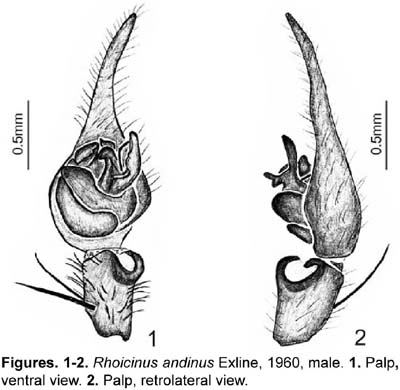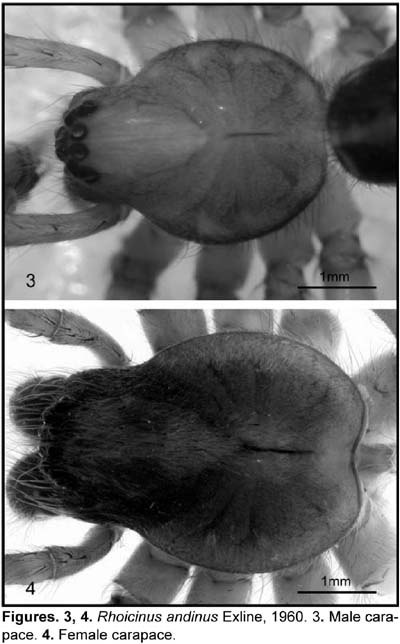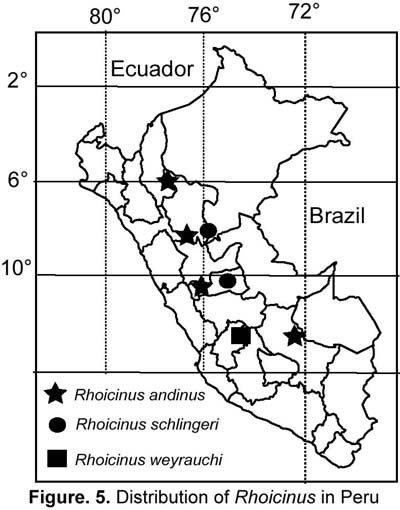Services on Demand
Journal
Article
Indicators
-
 Cited by SciELO
Cited by SciELO
Related links
-
 Similars in
SciELO
Similars in
SciELO  uBio
uBio
Share
Revista Peruana de Biología
On-line version ISSN 1727-9933
Rev. peru biol. vol.14 no.2 Lima Dec. 2007
NOTA CIENTÍFICA
Estevam Luís Cruz da Silva
Pontifícia Universidade Católica do Rio Grande do Sul (PUCRS), Laboratório de Aracnologia, Porto Alegre, Brasil.
Abstract
The male of Rhoicinus andinus Exline, 1960 is described for the first time, based on two specimens from Cashiari, Camisea River, Cusco, Peru. The genus Rhoicinus has four species recorded from Peru. R. andinus is recognized by having a larger and heavily sclerotized ring at the palpal tibiae. A new geographical distribution for the species is noted.
Keywords: spiders, taxonomy, Camisea, Peru.
Resumen
Por primera vez, se describe el macho de Rhoicinus andinus Exline, 1960, en base a dos ejemplares procedentes de Cashiari, Río Camisea, Cusco, Perú. El género Rhoicinus tiene cuatro especies descritas para el Perú. R. andinus se distingue de las restantes por tener un más grande y esclerotisado anillo en las tibias del palpo. Una nueva distribución geográfica para la especie es reportada.
Palabras clave: arañas, taxonomía, Camisea, Perú.
Introduction
The genus Rhoicinus Simon, 1898 currently includes ten species, found in Ecuador, Guyana, Peru, Venezuela and northern Brazil (Platnick, 2007). Simon (1898) established Rhoicinus to accommodate two new species, both of them known only from females: R. gaujoni, the type-species collected in Ecuador, and R. wapleri, from Venezuela. Recently, Brescovit & Höfer (1994) have described the male of R. gaujoni, extending the geographical range of this species to Brazil.
Exline (1950) described R. wallsi, based on a female from Ecuador. Later (1960), she described four additional species from Peru: R. rothi (male and female), R. schlingeri, R. andinus and R. weyrauchi (the latter three known from females, only). Other species included in the genus are R. fuscus (Caporiacco, 1947) (juvenile, Guyana), R. lugato Brescovit & Höfer, 1994 (male, Brazil) and R. urucu Brescovit & Oliveira, 1994 (male and female, Brazil). Species included in Rhoicinus can be distinguished from the remaining trechaleid genera by having a recurved posterior eye row, eyes often similar in size (sometimes subequal); lower margin of cheliceral groove with three teeth; posterior spinnerets longer than anterior ones; clypeus robust, higher than the diameter of anterior median eyes; usually three spines or spine-like bristles beneath anterior tibia; epigynal middle field with conspicuous copulatory openings (Exline, 1960).
The male of R. andinus is herein described based on the examination of the types of Rhoicinus deposited in the California Academy of Sciences (CAS): R. andinus (CAS 8651), R. schlingeri (CAS 8652) and R. weyrauchi (CAS 8653), as well as the original descriptions made by Exline (1960) and the type of habitat where each species occurs. Measurements and color pattern between the holotype of R. andinus and the unknown male specimens showed a significant degree of similarity, especially in body length and color of carapace and abdomen (Figs. 3—4).
Material and methods
The material examined is deposited in the collection of the Museo de Historia Natural of Universidad Nacional Mayor de San Marcos (MUSM, G. Lamas, D. Silva Dávila). Description and nomenclature of the male palpal structures follow Carico (1993) and Sierwald (1990). All the measurements are in millimeters.
Rhoicinus andinus Exline, 1960



Rhoicinus andinus Exline 1960:597, figs. 3, 7, 9, female holotype from Monson Valley, near Tingo Maria, Huánuco, Peru, December 2, 1954, E. I Schlinger and E. S. Ross leg., deposited in California Academy of Sciences (CAS 8651, examined). Platnick, 2007.
Diagnosis: Males of this species can be distinguished from those of R. lugato and R. gaujoni (Brescovit & Höfer, 1994, figs.1—3, 5—7) by having a larger and heavily sclerotized ring at the palpal tibiae, a cymbium without dorsal spines (Fig. 2) and a longer median apophysis (Figs. 1, 2).
Description: (Male allotype). Total length 7,3. Carapace 3,34 long; 2,75 wide, pale yellow, pale brown at the lateral margins, with dark bristles; pale yellow at the ocular region (Fig. 3). Chelicerae pale brown, with small pale brown bristles, not enlarged at the base, three promarginal teeth, equal in size and three retromarginal teeth, equal in size. Labium 0,52 long; 0,58 wide, pale yellow, light brown at the distal margin, darker at the anterior margin. Clypeus 0,16 high, 1,36 long, pale yellow, with long bristles at the posterior margin, dark lateral projections. Sternum 1,70 long; 1,58 wide; pale yellow, with small pale brown bristles. Eye diameters, interdistances and median ocular quadrangle: anterior eye row 0,93 wide, recurved, posterior row 0,96 wide, recurved. AME 0,18; ALE 0,15; PME 0,18; PLE 0,12; AME-AME 0,09; AME-ALE 0,43; PME-PME 0,45; PME-PLE 0,24; MOQ 0;45 long; dorsal view 0,53; frontal view 0;61. Abdomen 3,96; long, gray, longer than wide, moderately covered with setae, unmarked, venter light, unmarked. Legs, pale yellow ventrally, pale brown spots dorsally. Relative length of legs: IV-I-II-III. Measurements: I _ femur 5,22/ tibia-patella 7,47/ metatarsus 6,30/ tarsus 3,07/ total 22,06; II _ 4,89/6,47/ 5,97/ 2,98/ 20,31; III _ 3,90/ 4,98/ 4,23/ 2,24/ 15,35; IV _ 5,47/ 6,80/ 7,22/ 2,90/ 22,39. Ventral pairs of macrosetae on tibiae: I-4, II-4, III-3, IV-3. Palpus elongated, cymbium 1,64 long, distally narrowed (Fig. 1), without spines dorsally (Fig. 2), ventral division of median apophysis large and elongate, embolus conspicuous (Fig. 1).
Material examined: PERU, Cashiari, Camisea River, Cusco, Peru, (11º52'S; 72º39'W, 690 m elevation), 2 B&, 24.VII.1998, J. Duárez & S. Córdova leg. (MUSM).
Distribution: Cusco, Peru (Fig. 5).
Acknowledgments I would like to thank James E. Carico (Lynchburg College, Virginia, USA) and Arno Antonio Lise (MCTP, PUCRS) for comments on the manuscript. Juliane Picanço (PUCRS) for the edition of figures. I want also to thank my wife Juliane Picanço (PUCRS) for the photo of the male and Diana Silva Dávila (MUSM) for the photo of the female and the loan of the material. Charles Griswold (CAS) for the loan of the types. This study was supported by "Conselho Nacional de Desenvolvimento Científico e Tecnológico" (CNPq Nº 131713/2005-1).
Literature cited
Brescovit, A.D.; H. Höfer. 1994 On the spider genus Rhoicinus (Araneae, Trechaleidae) in a Central Amazonian inundation forest. J. Arachnol., 22: 54-59, 1994.
Carico, J.E. 1993 Revision of the genus Trechalea Thorell (Araneae, Trechaleidae) with a review of the taxonomy of the Trechaleidae and Pisauridae of the western hemisphere. J. Arachnol., 21: 226-257.
Exline, H. 1950 Spiders of the Rhoicininae (Pisauridae) from western Peru and Ecuador. Am. Mus. Novit., 1470: 20-34
Exline, H. 1960 Rhoicininae spiders (Pisauridae) of western South America. Proc. Calif. Acad. Sci., 29: 577-620.
Platnick, N. I. 2007 The World Spider Catalog, version 8.0. American Museum of Natural History, on line <http://research.amnh.org/entomology/spiders/catalog/>. Date of access: 03/08/2007.
Sierwald, P. 1990 Morphology and homologous features in the male palpal organ in Pisauridae and other spider families, with notes on the taxonomy of Pisauridae (Arachnida: Araneae). Nemouria (Occas. Pap. Delaware Mus. Nat. Hist.), 35: 1_59.
Simon, E. 1898 Description d'un noveau genre d'arachnides de la famille des Lycosides. Bull. Soc. ent. France, 3: 129-130.
Correspondencia
Email: Estevam Luís Cruz da Silva: estevamsilva@gmail.com
Presentado: 20/04/2007
Aceptado: 02/08/2007













